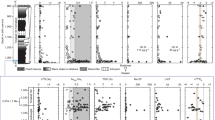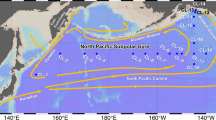Abstract
Benthic foraminiferal and sediment biogeochemical data (total organic carbon, calcium carbonate and biogenic opal contents) in two cores (1265 and 1312 m water depths) from the southeastern Sakhalin slope and one core (839 m water depth) from the southwestern Kamchatka slope were investigated to reconstruct variations of the oxygen minimum zone during the last 50 ka in the Okhotsk Sea. The oxygen minimum zone was less pronounced during cooling in the MIS 2 that is suggested to be caused by a maximal expansion of sea ice cover, decrease of marine productivity and increase of production of the oxygenated Okhotsk Sea Intermediate Water (OSIW). A two-step-like strengthening of oxygen minimum zone during the warmings in the Termination 1a and 1b was linked to (1) enhanced oxygen consumption due to degradation of large amount of organic matter in the water column and bottom sediments, originated from increased marine productivity and supply of terrigenous material from the submerged northern shelves; (2) sea ice cover retreat and reduction of OSIW production; (3) freely inflow of the oxygen-depleted intermediate water mass from the North Pacific.
Similar content being viewed by others
References
N. V. Arzhanova and V. L. Zubarevich, “Seasonal Changes in the Content of Biogenic Elements in the Sea of Okhotsk as a Basis for Assessment of Phytoplankton Production,” in Multidisciplinary Studies of the Ecosystem of the Sea of Okhotsk (VNIRO, Moscow, 1997), pp. 92–96 [in Russian].
M. S. Barash and N. V. Bubenshchikova, G. Kh. Kazarina, and T. A. Khusid, “Paleoceanography of the Central Part of the Sea of Okhotsk over the Past 200 ky (on the Basis of Micropaleontological Data),” Okeanologiya 41(5), 755–767 (2001) [Oceanology 41 (5), 723–735 (2001)].
S. V. Bruevich, A. N. Bogoyavlenskii, and V. V. Mokievskii, “Hydrochemical Characteristics of the Sea of Okhotsk,” Tr. Inst. Okeanol. Akad. Nauk SSSR 42, 125–199 (1960) [in Russian].
Yu. P. Vasilenko and S. A. Gorbarenko, “Changes in Ice Distribution in the Sea of Okhotsk in Late Pleistocene and Holocene,” in Proceedings of XVII International Scientific School on Marine Geology (GEOS, Moscow, 2007), Vol. 1, pp. 179–181 [in Russian].
S. A. Gorbarenko and E. L. Gol’dberg, “Assessment of Variations of Primary Production in the Sea of Okhotsk, Bering Sea, and Northwestern Pacific over the Last Glaciation Maximum and Holocene,” Dokl. Akad. Nauk 405(5), 673–676 (2005) [Dokl. 405A (9), 1380–1383 (2005)].
A. N. Derkachev, N. A. Nikolaeva, A. V. Mozherovskii, et al., “Signs of Existence of Anoxic Conditions of Sedimentogenesis in Local Basins of the Sea of Okhotsk in Late Pleistocene and Holocene,” Tikhookean. Geol. 26(3), 3–33 (2007) [in Russian].
V. Yu. Leskov and S. A. Gorbarenko, “Reconstruction of Ice Conditions in the Okhotsk Sea for the Past 24000 Yrs Based on IRD Distribution,” Tikhookean. Geol. 22(4), 41–47 (2003).
K. V. Moroshkin, Water Masses of the Sea of Okhotsk (Nauka, Moscow, 1966) [in Russian].
Kh. M. Saidova, Ecology of Foraminifers in the Far East. Seas of the USSR and Northwestern Pacific (Akad. Nauk SSSR, Moscow, 1961) [in Russian].
Kh. M. Saidova, “Communities of Benthic Foraminifera in the Bering Sea and the Sea of Okhotsk,” Okeanologiya 37(1), 105–112 (1997) [Oceanology 37 (1), 97–104 (1997)].
T. A. Khusid, M. S. Barash, N. Biebow, et al., “Late Quaternary Environmental Changes on the Southeastern Slope of the Sea of Okhotsk Inferred from Benthic Foraminifera,” Okeanologiya 40(3), 434–438 (2005) [Oceanology 45 (3), 413–419 (2005)].
J. M. Bernhard and B. K. Sen Gupta, Modern Foraminifera, Ed. by B. K. Sen Gupta (Kluwer Academic Publ., 1999), pp. 161–179.
“Cruise Reports: KOMEX I and II. RV “Akademik M.A. Lavrentyev” Cruise 28, GEOMAR Report, Ed. by N. Biebow and E. E. Hütten, (1999), Vol. 82.
N. Bubenshchikova, D. Nürnberg, L. Lembke-Jene, and N. Pavlova, “Living Benthic Foraminifera of the Okhotsk Sea: Faunal Composition, Standing Stocks and Microhabitats,” Mar. Micropalaeontol. 69, 314–333 (2008) [doi: 10.1016/j.marmicro.2008.09.002].
K. G. Cannariato and J. P. Kennett, “Climatically Related Millennial-Scale Fluctuations in Strength of California Margin Oxygen-Minimum Zone during the Past 60 k.y,” Geology 27, 975–978 (1999).
“COHMAP Members. Climatic Changes of the Last 18.000 Years: Observations and Model Simulations,” Science, 241, 1043–1052 (1988).
B. H. Corliss, “Microhabitats of Benthic Foraminifera within Deep-Sea Sediments,” Nature 314, 435–438 (1985).
J. Crusius, T. F. Pedersen, S. Kienast, et al., “Influence of Northwest Pacific Intermediate Water Oxygen Concentrations during the Bolling-Allerod Interval (14.7–12.9 ka),” Geology 32(7), 633–636 (2004).
S. Gladyshev, L. Talley, G. Kantakov, et al., “Distribution, Formation, and Seasonal Variability of Okhotsk Sea Mode Water,” J. Geophys. Res. 108(C6), 3186 (2003) [doi: 10.1029/2001JC000877].
S. A. Gorbarenko, T. A. Khusid, I. A. Basov, et al., “Glacial Holocene Environment of the Southeastern Okhotsk Sea: Evidence from Geochemical and Paleontological Data,” Palaeogeogr. Palaeoclimatol. Palaeoecol. 177, 237–263 (2002).
S. A. Gorbarenko, E. L. Goldberg, M. Kashgarian, et al., “Millennium Scale Environment Changes of the Okhotsk Sea During Last 80 kyr and Their Phase Relationship with Global Climate Changes,” J. Oceanogr. 63(4), 609–623 (2007).
I. L. Hendy and J. P. Kennett, “Tropical Forcing of North Pacific Intermediate Water Distribution during Late Quaternary Rapid Climate Changes?,” Quat. Sci. Rev. 22, 673–689 (2003).
J. Imbrie, E. A. Boyle, S. C. Clemens, et al., “On the Structure and Origin of Major Glaciation Cycles. 1. Linear Responses to Milankovitch Forcing,” Paleoceanography 7, 701–738 (1992).
K. Kaiho, “Benthic Foraminiferal Dissolved-Oxygen Index and Dissolved-Oxygen Levels in the Modern Ocean,” Geology 22, 719–722 (1994).
L. D. Keigwin, “Glacial-Age Hydrology of the Far Northwest Pacific,” Paleoceanography 13, 323–339 (1998).
J. E. Klovan and J. Imbrie, “An Algorithm and Fortran IV Program for Large-Scale Q-Mode Analysis,” Mathem. Geol. 3, 7–61 (1971).
P. Loubere and M. Fariduddin, Modern Foraminifera, Ed. by B. K. Sen Gupta (Kluwer Academic Publ., 1999), pp. 181–199.
A. Mackensen, G. Schmiedl, J. Harloff, and M. Giese, “Deep-Sea Foraminifera in the South Atlantic Ocean: Ecology and Assemblages Generation,” Micropaleontology 41(4), 342–358 (1995).
D. G. Martinson, N. G. Pisias, J. D. Hays, et al., “Age Dating and the Orbital Theory of the Ice Ages: Development of a High-Resolution 0 to 300.000-Year Chronostratigraphy,” Quaternary Res. 27, 1–29 (1987).
P. A. Meyers, “Preservation of Elemental and Isotopic Source Identification of Sedimentary Organic Matter,” Chem. Geol. 144, 289–302 (1994).
H. T. Müllins, J. B. Thompson, K. McDougall, and T. L. Vercoutere, “Oxygen-Minimum Zone Edge Effects: Evidence from the Central California Coastal Upwelling System,” Geology 13, 491–494 (1985).
D. Nürnberg and R. Tiedemann, “Environmental Change in the Sea of Okhotsk during the Last 1.1 Million Years,” Paleoceanography 19, A4011 (2004) [PA4011, doi: 10.1029/2004PA001023].
Y. Okazaki, K. Takahashi, K. Katsuki, et al., “Late Quaternary Paleoceanographic Changes in the South-western Okhotsk Sea: Evidence from Geochemical, Radiolarian, and Diatom Records,” Deep-Sea Res. II 52, 2332–2350 (2005).
A. Ono, K. Takahashi, Y. Katsuki, et al., “The Dansgaard-Oeschger Cycles Discovered in the Up Stream Source Region of the North Pacific Intermediate Water Formation,” Geophys. Rev. Lett. 32(L11607) 1–4 (2005) [doi: 10.1029/2004GL022260].
J. D. Ortiz, S. B. O’Connell, J. DelViscio, et al., “Enhanced Marine Productivity Off Western North America during Warm Climate Intervals of the Past 52 k.y,” Geol. Soc. Am. 32(6), 521–524 (2004).
Y. Sakaguchi, “Cooling Around 9000 BP Caused by Permafrost Melt Water Burst,” Bull. Dept. Geogr. Univ. Tokyo 24, 1–6 (1992).
A. Salyuk, V. Sosnin, A. Obzhirov, et al., “Water column studies,” Cruise Reports: RV “Akademik M.A. Lavrentyev“ Cruise 29, Ed. by N. Biebow et al. GEOMAR Reports 110, 110–112 (2003).
K. Sawada and N. Handa, “Variability of the Path of the Kurosio Ocean Current Over the Past 25.000 Years,” Nature 392, 592–595 (1998).
O. Seki, M. Ikehara, K. Kawamura, et al., “Reconstruction of Paleoproductivity in the Sea of Okhotsk Over the Last 30 kyr,” Paleoceanography 19, A1016 (2004) [doi: 10.1029/2002Pa000808].
O. Seki, K. Kawamura, T. Sakamoto, et al., “Decreased Surface Salinity in the Sea of Okhotsk during the Last Glacial Period Estimated from Alkenones,” Geophys. Rev. Lett. 32(L08710) 1–4 (2005) [doi:10.1029/20024GL022177].
Y. Ternois, K. Kawamura, L. Keigwin, et al., “A Biomarker Approach for Assessing Marine and Terrigenous Inputs to the Sediments of Sea of Okhotsk for the Last 27.000 Years,” Geochim. Cosmochim. Acta 65(5), 791–802 (2001).
Author information
Authors and Affiliations
Corresponding author
Additional information
Original Russian Text © N.V. Bubenshchikova, D.Nürnberg, S.A. Gorbarenko, L. Lembke-Jene, 2010, published in Okeanologiya, 2010, Vol. 50, No. 1, pp. 99–113.
The article was translated by the authors.
Rights and permissions
About this article
Cite this article
Bubenshchikova, N.V., Nürnberg, D., Gorbarenko, S.A. et al. Variations of the oxygen minimum zone of the Okhotsk Sea during the last 50 ka as indicated by benthic foraminiferal and biogeochemical data. Oceanology 50, 93–106 (2010). https://doi.org/10.1134/S000143701001011X
Received:
Accepted:
Published:
Issue Date:
DOI: https://doi.org/10.1134/S000143701001011X




